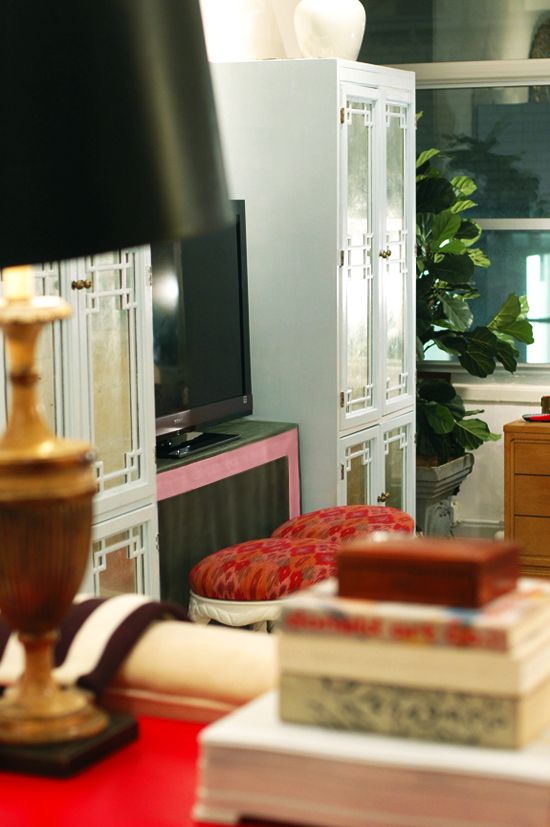This post is sponsored by Glad. We’re taking small steps to do our part and want to help you waste less too. Visit GLAD.com for more information.
I'm so excited to finally share this tutorial with you! This skirted table is my fourth or fifth of these DIYs, between my house and my client projects (remember the original one here?), but somehow I haven't managed to put together a tutorial until now. The steps are simple and completely NO-SEW! Ready to jump in?

After we moved to New York, I was looking everywhere for a bookshelf or console table to use as the base for a skirted console for our TV to go between the two fretwork cabinets. I checked Craigslist for a couple weeks with no luck, and just as I was about to cave and buy something new, Michael came to the rescue. One of our neighbors left this vintage bookshelf in our building's recycling room. Not only were the dimensions *perfect* but I was glad to save this sturdy little piece of furniture and give it a new life.

I've been trying to add some still-bright-but-less-primary colors to my living room. I told my friend that I was buying a forest green velvet for my console and some burgundy linen for my settee and she gave me the most hilarious look and goes "WHAT.THE.90s!!!!!! Gross!!!!" :)
Look how pretty the green is though! Mossy and muddy with a tiny bit of blue undertone. I lucked out and got it on eBay for $4/yd.
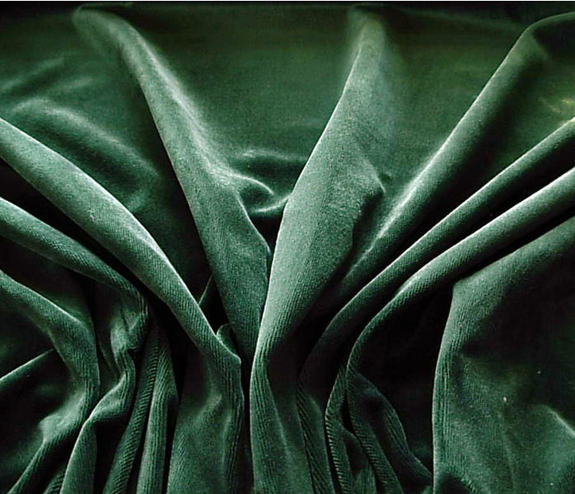
Before the fabric arrived, I went trim shopping at JEM in Tribeca (they have a killer selection of vintage trimmings) and found this really pretty lilac herringbone trim. I wasn't looking for something purple at all, but I had just finished reading Katie Ridder's new book Rooms (sooooo good, btw), so lavender was on the brain and the color drew me in.
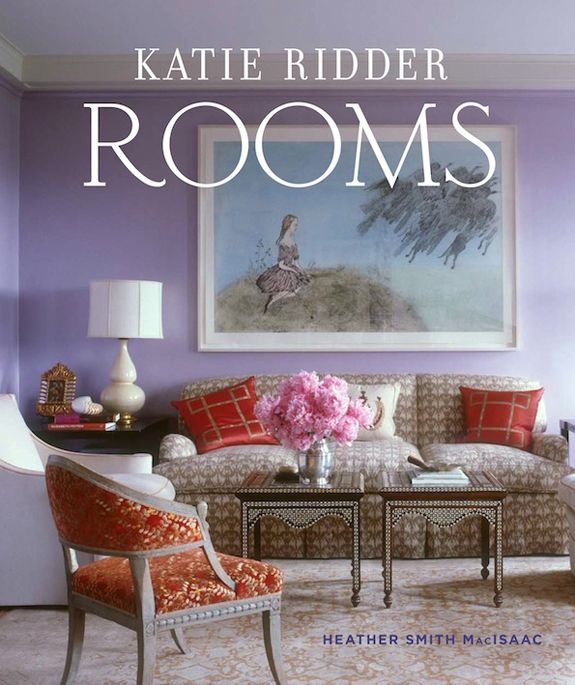
And then for the first time in my life, I was thrilled to see an astroturf rug. JEM has a green grass rug that seemed close to my velvet that was being shipped. I loved the colors together! Sold.

I was still happy with the color combo when the velvet arrived and couldn't wait to get started. I wiped the recycled bookshelf down with a bleach-water solution and got my fabric, trim and supplies ready...
Here's what you'll need for a no-sew skirted console:
Iron
Tape measure
Tailor's chalk
Scissors
Magnatac or other strong fabric glue
Staple gun and staples
STEP 1 - MEASURING and CUTTING
Measure your bookshelf/console and come up with a game plan with your measurements. I added 2" of hem to every side and 3" of hem to every BOTTOM (no hems on the top!!).

Components are as follows, in order of appearance:
1) Inside flaps (green)
These two flaps will hardly be seen. They are like camisoles for you console. No one wants to see bare corners! Cover them up with some simple flaps. Mine were about 4" wide on the front and another 4" wrapped around to the side. I added 4" more for my two 2" side hems, and 3" to the bottom just to keep things neat and to minimize fraying.
2) Side panels (purple)
There are also two of these panels, made to be the exact depth of your bookshelf sides. You'll want a good 3 or 4" of extra fabric for the top in addition to a 3" bottom hem. Again, don't forget to add 2" for each side hem.
3) Front panel (yellow)
One big flap that covers the top and fronts of your bookshelves. Again, at least 4" of extra fabric after your hem, for the top part where you're stapling.
4) Top panel (pink)
Made to fit the top of your bookshelf perfectly. Just add a 2" hem on all sides.

Now that you're all organized and prepped with your measurements, mark out all your pieces with a tape measure and tailor's chalk on the back side of the fabric and cut them out. If you are using velvet like I did, make sure not to mess with the orientation of the pieces. You want the piles of each piece to lay in the same direction or else the sheen and color appearance will be totally off. (This applies to other velvet upholstery projects as well! Be careful with the pile directions!)


STEP 2 - PRESSING and GLUEING
My mom always says the most important part of any sewing or soft goods project is the pressing. It's so true!! For velvet, you don't want to iron directly on the pile. I used a tea towel as a protective barrier and that worked fine to give me a strong crease for all my hems. Again, I did about 2" on all sides and 3" along the bottom. I used my tailor's chalk markings and a ruler to keep my hems even.

Then simply put down an even coat of fabric glue on the hem flap. By keeping the glue application to just the flap you're reducing the chances of leaking. I glued the sides first and the bottom hem last.

This is getting a little nit-picky, but try not to let the side flaps poke out of bottom hem sides. You might have to overcompensate and pull in those side flaps a little more before glueing the bottom hem.

STEP 3 - HANGING and STAPLING
Once all your pieces have been ironed and glued, it's time to assemble! Go in order of the chart above. First are the inside flaps. So, the real trick of a no-sew skirted table is to focus on the break of the hem, not so much on the top part yet. It doesn't matter how much fabric is on top or if it's crooked or whatever, just move the panel vertically until it perfectly and evenly hits the ground. I probably like it best with a 1/4" break. Nothing is worse than too-short curtains or console skirts!

After finding the right length, just put in a staple every two inches or so to keep the fabric in place without sagging. I couldn't be happier with my Powershot Pro staple gun (used with Powershot Staples - it makes a serious difference!).

After hanging the inside flaps, do the side flaps next, and then the front piece.

Because velvet was so thick, I didn't want too many edges on the top. So I took the top piece all the way to the back. This really helped to keep the top surface flat and even out all those edges from the other pieces.


I could have stopped with this step and have the front piece be the top piece too, but I really wanted this to look like a sewn skirt, with seams.
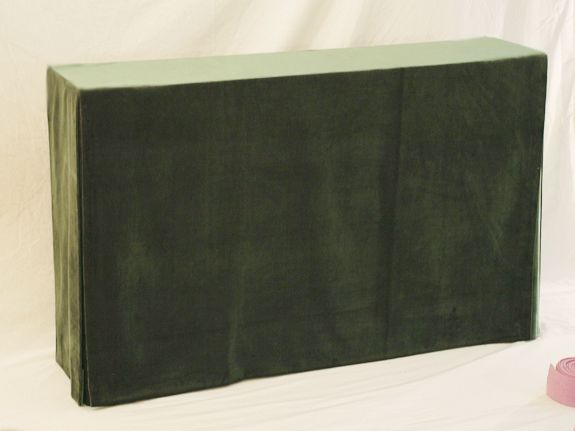
Before putting on the top though, I glued on the trim. My assistant Colleen and I went back and forth on whether to do a full boxed border, but the trim is so thick we decided to go with the upside-down U, and I really like it.
Remember to always inset your glue line about 1/4" from the edge, otherwise the glue will leak out from underneath when you press the trim into place.

I don't like to cut trim for mitered corners. It never looks right to me. The trick to folding a mitered corner is to keep all your fold angles at 90 degrees and 45 degrees.

You have to play with it for a minute to get the trim to lay right, then glue in all the folds and really crease and press the folds into place.

Then finish off your trim with a little turned under hem.

The last step is securing the top piece, so don't put away the glue just yet. Glue evenly and press down hard to make everything lay flat.

You can see in the photos above and below how the inside flaps cover the corners.

All done and nary a needle or Singer in sight!

We have all our cable and video components under the skirt. The remote works with a little sensor thing we got off Amazon.
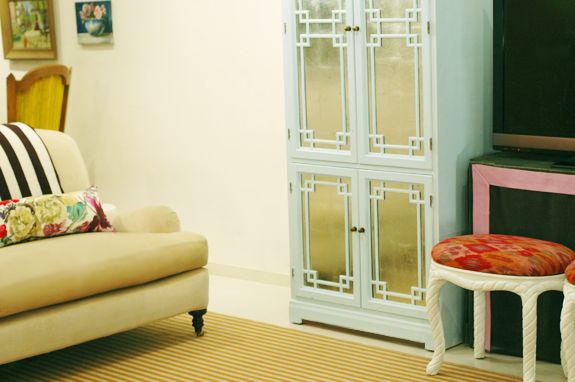
Everything's still easily accessible, but completely hidden. I love, love, love skirted consoles for any house, but especially for small homes or apartments where every piece of furniture really has to count. You can pack a lot of stuff under there!
As a side note, I know some decorators really hate a glass top on skirted consoles, but I'm thinking it's a necessity here. Between the dust and the sticky little fingers, I'm pretty sure I'm going to want a protective surface on top of that velvet!
